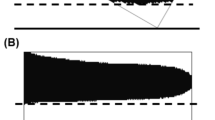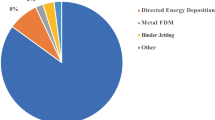Abstract
In laser metal deposition of overhanging geometries, non-planar layers are used to partially avoid the highly inconvenient support structures. Multi-axis machines provide extra degrees of freedom that allow the deposition of non-planar layers. However, path planning for non-planar slicing is complex because, in most geometries, it encourages non-homogeneous metal deposition among the dispenser paths. For workpieces presenting a direction normal to which all cross sections have non-null common kernel (called here “revolute workpieces”), it is possible to use a cylindrical (i.e., iso-radial) slicing which still enables homogeneous path generation and metal deposition. This manuscript presents the implementation and experimental validation of a path-planner for laser deposition metal dispensers which build revolute workpieces by stacking iso-radial layers. Isometry is preserved between each 3D cylindrical layer and the 2D parametric space \((\kappa ,\gamma )\) where the dispenser path is planned, so deposed metal density can be homogenized. The path-planner takes advantage of the natural isometry between the \((\kappa ,\gamma )\) flat surface and the 3D cylinder (due to the cylinder developability). This isometry allows for (i) the application of conventional 2D dispenser path planning for 3D iso-radial layers and (ii) the control of inter-bead distance and dispenser velocity. The implemented path-planner also allows the control of the deposed thickness for each iso-radial layer. To validate experimentally our strategy, we manufacture spur and helical gear teeth on a cylindrical substrate. The results of these experiments show that our strategy generates toolpaths suitable for the manufacturing of industrial workpieces via laser metal deposition.















Similar content being viewed by others
Data Availability
The data in this study is not available due to industrial secrecy related to this project.
Abbreviations
- AM:
-
Additive manufacturing.
- B-Rep:
-
Boundary representation of a solid object in \(\mathbb {R}^3\).
- LMD:
-
Laser metal deposition.
- (x, y, z):
-
Convention triplet for Cartesian coordinates.
- \((\theta ,\rho ,u)\) :
-
Convention triplet for cylindrical coordinates. \(\theta \) is the azimuth angle. \(\rho \) is the axial distance from the z-axis. u is the height.
- \((\kappa ,\gamma ,v)\) :
-
Convention triplet for the coordinates on the parametric space (isometry cylinder-plane). In this space, the planes \(v = c\) are isometric to a cylinder in Cartesian coordinates with radius c and axis the z-axis.
- \(\pmb {g}: \mathbb {R}^3 \rightarrow \mathbb {R}^3\) :
-
Function to transform from Cartesian (x, y, z) to cylindrical coordinates \((\theta , \rho ,\) u).
- \(\pmb {w}: \mathbb {R}^3 \rightarrow \mathbb {R}^3\) :
-
Function to transform from cylindrical \((\theta , \rho , u)\) to parametric coordinates \((\kappa , \gamma , v)\).
- \(\pmb {h}: \mathbb {R}^3 \rightarrow \mathbb {R}^3\) :
-
Function to transform from parametric \((\kappa , \gamma , v)\) to Cartesian coordinates (x, y, z).
- \(\textrm{dist}(\pmb {W}_1, \pmb {W}_2)\) :
-
Euclidean distance between \(\pmb {W}_1\) and \(\pmb {W}_2\).
- \(\textrm{dist}_\textrm{geod}(\pmb {P}_1, \pmb {P}_2)\) :
-
Geodesic distance (arc-length measured on the cylinder surface) between \(\pmb {P}_1\) and \(\pmb {P}_2\).
- \(\mathcal {M} \subset \mathbb {R}^3\) :
-
2-Manifold embedded in \(\mathbb {R}^3\). Geometry to be manufactured.
- \(\mathcal {F} \subset \mathcal {M}\) :
-
Face of \(\mathcal {M}\) that is also a subset of a cylinder.
- \(\textrm{Ker}(Q) \subset \mathbb {R}^2\) :
-
Kernel of a planar polygon Q. Convex subset of Q from which every point on the boundary of Q is visible.
- \(M = (V,T)\) :
-
Triangular mesh. V and T are the set of vertices and triangles, respectively. Piecewise linear discretization of the 2-manifold \(\mathcal {M}\).
- \(t > 0\) :
-
Layer thickness (mm).
- \(d > 0\) :
-
Step-over distance, i.e., distance between two consecutive deposition lines (beads) (mm).
References
Leino M, Pekkarinen J, Soukka R (2016) The role of laser additive manufacturing methods of metals in repair, refurbishment and remanufacturing - enabling circular economy. Phys Procedia 83:752–760. https://doi.org/10.1016/j.phpro.2016.08.077
Shan Y, Gan D, Mao H (2021) Curved layer slicing based on isothermal surface. Procedia Manufacturing 53:484–491. https://doi.org/10.1016/j.promfg.2021.06.081
Xu K, Li Y, Chen L, Tang K (2019) Curved layer based process planning for multi-axis volume printing of freeform parts. Comput Aided Des 114:51–63. https://doi.org/10.1016/j.cad.2019.05.007
Dai C, Wang CCL, Wu C, Lefebvre S, Fang G, Liu Y-J (2018) Support-free volume printing by multi-axis motion. ACM Trans Graph 37(4):134. https://doi.org/10.1145/3197517.3201342
Montoya-Zapata D, Moreno A, Ortiz I, Ruiz-Salguero O, Posada J (2022) Cylindrical transform slicing of revolute parts with overhangs for laser metal deposition. In: Posada J, Serrano A (eds) Spanish Computer Graphics Conference (CEIG). The Eurographics Association, Vic, Spain, pp 17–21. https://doi.org/10.2312/ceig.20221141
Ding Y, Dwivedi R, Kovacevic R (2017) Process planning for 8-axis robotized laser-based direct metal deposition system: a case on building revolved part. Robot Comput Integr Manuf 44:67–76. https://doi.org/10.1016/j.rcim.2016.08.008
Etienne J, Ray N, Panozzo D, Hornus S, Wang CCL, Martínez J, McMains S, Alexa M, Wyvill B, Lefebvre S (2019) CurviSlicer: slightly curved slicing for 3-axis printers. ACM Trans Graph 38(4):81. https://doi.org/10.1145/3306346.3323022
Zhao G, Ma G, Feng J, Xiao W (2018) Nonplanar slicing and path generation methods for robotic additive manufacturing. The Int J Adv Manuf Technol 96(9–12):3149–3159. https://doi.org/10.1007/s00170-018-1772-9
Xie F, Jing X, Zhang C, Chen S, Bi D, Li Z, He D, Tang K (2022) Volume decomposition for multi-axis support-free and gouging-free printing based on ellipsoidal slicing. Comput Aided Des 143:103135. https://doi.org/10.1016/j.cad.2021.103135
Yigit IE, Lazoglu I (2020) Spherical slicing method and its application on robotic additive manufacturing. Progress in Additive Manufacturing 5(4):387–394. https://doi.org/10.1007/s40964-020-00135-5
Eisenbarth D, Menichelli A, Soffel F, Wegener K (2021) Adaptive slicing and process optimization for direct metal deposition to fabricate exhaust manifolds. In: Meboldt M, Klahn C (eds) Industrializing Additive Manufacturing. Springer, Cham, pp 160–173. https://doi.org/10.1007/978-3-030-54334-1_12
Ruan J, Eiamsa-ard K, Liou FW (2005) Automatic multi-axis slicing based on centroidal axis computation. In: International Design Engineering Technical Conferences and Computers and Information in Engineering Conference. Volume 3: 25th Computers and Information in Engineering Conference, Parts A and B, Long Beach, CA, USA, pp 383–393. https://doi.org/10.1115/DETC2005-85261
Wu C, Dai C, Fang G, Liu Y-J, Wang CCL (2017) RoboFDM: a robotic system for support-free fabrication using FDM. In: 2017 IEEE International Conference on Robotics and Automation (ICRA), pp 1175–1180. https://doi.org/10.1109/ICRA.2017.7989140
Ding D, Pan Z, Cuiuri D, Li H, Larkin N, van Duin S (2016) Automatic multi-direction slicing algorithms for wire based additive manufacturing. Robot Comput Integr Manuf 37:139–150. https://doi.org/10.1016/j.rcim.2015.09.002
Gao Y, Wu L, Yan D-M, Nan L (2019) Near support-free multi-directional 3D printing via global-optimal decomposition. Graph Model 104:101034. https://doi.org/10.1016/j.gmod.2019.101034
Wu C, Dai C, Fang G, Liu Y-J, Wang CCL (2020) General support-effective decomposition for multi-directional 3-D printing. IEEE Trans Autom Sci Eng 17(2):599–610. https://doi.org/10.1109/TASE.2019.2938219
Xiao X, Joshi S (2020) Process planning for five-axis support free additive manufacturing. Additive Manufacturing 36:101569. https://doi.org/10.1016/j.addma.2020.101569
Xu K, Chen L, Tang K (2019) Support-free layered process planning toward 3 + 2-axis additive manufacturing. IEEE Trans Autom Sci Eng 16(2):838–850. https://doi.org/10.1109/TASE.2018.2867230
Calleja A, Tabernero I, Fernández A, Celaya A, Lamikiz A, López de Lacalle LN (2014) Improvement of strategies and parameters for multi-axis laser cladding operations. Opt Lasers Eng 56:113–120. https://doi.org/10.1016/j.optlaseng.2013.12.017
González-Barrio H, Calleja-Ochoa A, López de Lacalle LN, Lamikiz A (2022) Hybrid manufacturing of complex components: full methodology including laser metal deposition (LMD) module development, cladding geometry estimation and case study validation. Mech Syst Signal Process 179. https://doi.org/10.1016/j.ymssp.2022.109337
Xie F, Bi D, Tang K (2020) A potential field based multi-axis printing path generation algorithm. Int J Comput Integr Manuf 33(12):1277–1299. https://doi.org/10.1080/0951192X.2020.1815851
Bi D, Xie F, Tang K (2021) Generation of efficient iso-planar printing path for multi-axis FDM printing. Journal of Manufacturing and Materials Processing 5(2):59. https://doi.org/10.3390/jmmp5020059
Dai F, Zhang H, Li R (2020) Process planning based on cylindrical or conical surfaces for five-axis wire and arc additive manufacturing. Rapid Prototyping Journal 26(8):1405–1420. https://doi.org/10.1108/RPJ-01-2020-0001
Pan S-H, Yao G-C, Cui Y-N, Meng F-S, Luo C, Zheng T-Q, Singh G (2023) Additive manufacturing of tungsten, tungsten-based alloys, and tungsten matrix composites. Tungsten 5(1):1–31. https://doi.org/10.1007/s42864-022-00153-6
Monkova K, Zetkova I, Kučerová L, Zetek M, Monka P, Daňa M (2019) Study of 3D printing direction and effects of heat treatment on mechanical properties of MS1 maraging steel. Arch Appl Mech 89(5):791–804. https://doi.org/10.1007/s00419-018-1389-3
Alomarah A, Zhang J, Ruan D, Masood S, Lu G (2017) Mechanical properties of the 2D re-entrant honeycomb made via direct metal printing. IOP Conference Series: Materials Science and Engineering 229(1):012038. https://doi.org/10.1088/1757-899X/229/1/012038
Montoya-Zapata D, Creus C, Ortiz I, Alvarez P, Moreno A, Posada J, Ruiz-Salguero O (2021) Generation of 2.5D deposition strategies for LMD-based additive manufacturing. Procedia Computer Science 180:280–289. https://doi.org/10.1016/j.procs.2021.01.165
Pressley A (2010) The first fundamental form. In: Elementary Differential Geometry. Springer, London, pp 121–157. https://doi.org/10.1007/978-1-84882-891-9_6
Calleja A, Bo P, González H, Bartoň M, López de Lacalle LN (2018) Highly accurate 5-axis flank CNC machining with conical tools. The Int J Adv Manuf Technol 97(5):1605–1615. https://doi.org/10.1007/s00170-018-2033-7
Funding
This work has been partially funded by the Basque Government under ELKARTEK program (grants KK-2018/00115 (ADDISEND) and KK-2018/00071 (LANGILEOK)) and by the INZU Group (Talens Systems and Ikergune A.I.E.).
Author information
Authors and Affiliations
Corresponding author
Ethics declarations
Conflict of interest
The authors declare that they have no conflicts of interest.
Additional information
Publisher's Note
Springer Nature remains neutral with regard to jurisdictional claims in published maps and institutional affiliations.
Rights and permissions
Springer Nature or its licensor (e.g. a society or other partner) holds exclusive rights to this article under a publishing agreement with the author(s) or other rightsholder(s); author self-archiving of the accepted manuscript version of this article is solely governed by the terms of such publishing agreement and applicable law.
About this article
Cite this article
Montoya-Zapata, D., Moreno, A., Ortiz, I. et al. Computer supported toolpath planning for LMD additive manufacturing based on cylindrical slicing. Int J Adv Manuf Technol 128, 4667–4683 (2023). https://doi.org/10.1007/s00170-023-12177-4
Received:
Accepted:
Published:
Issue Date:
DOI: https://doi.org/10.1007/s00170-023-12177-4




